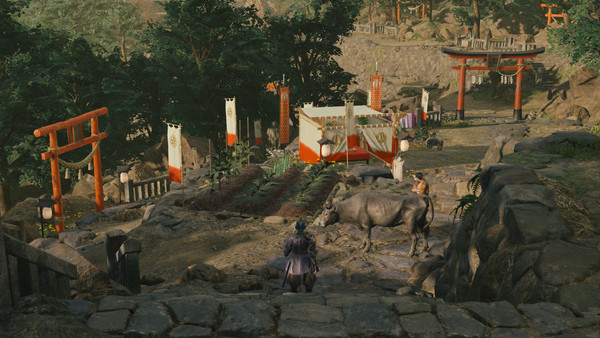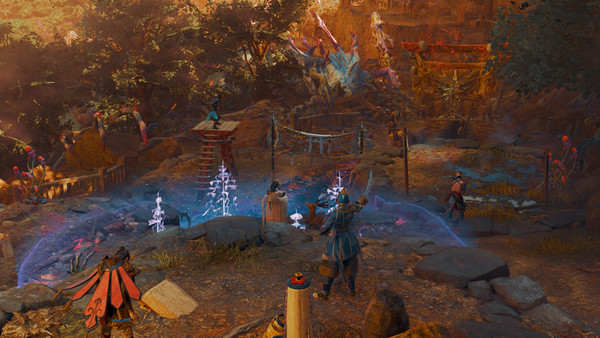Kunitsu-Gami: Path of the Goddess Game Review – Game Review

The first thing you will likely notice about Kunitsu-Gami: Path of the Goddess is how utterly spellbinding its world is. The lead director of the game is Shuichi Kawata, and it is immediately apparent how he is drawing on his experience as an art director and cinematic designer for games like Shinsekai: Into the Depths and the Resident Evil franchise to craft the world of Kunitsu-gami into something truly striking and memorable. There is just so much confidence with which the game presents its unique and stylized take on a fairy-tale version of Japan, where the demons and yokai of myth have come creeping into the world to spread their dark Defilement. The many stages of Mt. Kafuku that you will visit are intricate dioramas as much as they are levels in a video game, and there is a lot of joy to be had in simply feasting on the visual splendors and horrors that CAPCOM has once again wrangled out of its ever versatile RE Engine.
©CAPCOM

©CAPCOM
The next thing you will catch on to comes once the beautiful and intriguing opening cinematic is finished, and you actually begin playing Kunitsu-Gami, and it is that its gameplay is as unique as the rest of its presentation. Simply put, this is a combination of visceral hack-n’-slash action and more strategic tower-defense gameplay, with a smattering of RPG development thrown in for good measure. You begin each stage with a simple directive: Protect Yoshiro as she dances and chants her way across the level until she can purify the Torii gate that the Seethe forces are using to invade Mt. Kafuku. As Soh, you have complete freedom to run and jump around the stage as you chop up all the creepy crawlies pouring out of the gate with beautiful (but relatively simplistic) simple attack and “dance” attack combos. Now, so far as movesets and weapon options go, Soh is no Dante, but Kunitsu-Gami isn’t trying to be Devil May Cry, either. The warrior’s gorgeously choreographed swordplay and enigmatic demeanor suit this game perfectly.

©CAPCOM
Besides, the core twist of Kunitsu-Gami’s gameplay is that Soh won’t be enough on their own to win the day. The sheer number of Seethe you encounter will necessitate putting the rescued mountain villagers to work by assigning them different class roles and having them help stave off the demonic forces. As such, with a simple press of the left shoulder button on the gamepad, Kunitsu-gami will pause the real-time action so that you can strategically place your allies around the stage and focus their attacks or supporting abilities. At first, you will begin with just a couple of options, like the Woodcutter and the Archer, which are your standard melee and ranged units. Eventually, though, you will unlock even more “masks” that you can use to swap to a variety of more specialized roles on the fly, such as the enemy enfeebling Ascetic, the healing Shaman, the AOE-pounding Sumo Wrestler, and so on. Each one of these classes comes with its own set of upgrades that you can unlock with the game’s “Musubi” points. These points can be respecced at any time for no cost, meaning that Kunitsu-Gami never makes you feel like you’re going to be punished for experimenting with different combinations of builds and upgrades.

©CAPCOM

©CAPCOM
It’s a good thing, too, because Kunitsu-Gami goes out of its way to provide a plethora of challenges across its many stages and boss encounters that will encourage players to try all sorts of different approaches. At first, I was expecting Kunitsu-Gami to be a typical AA-game experience in terms of length and content, but as I kept proceeding through the increasingly challenging and diverse maps, I was continually impressed with how much the game has going on between all of its different systems and modes. In between the day/night cycles of the action stages and boss fights, Soh is also tasked with helping the surviving villagers of the different levels rebuild their homes; by assigning villagers to different projects and returning to them after completing more levels, Soh can acquire more Musubi with which to upgrade abilities, along with a dizzying number of collectible plaques, models, and so on. There are also several optional challenges that you can attempt with each of the action stages, and completing them will unlock even more upgrade points and extra lore tidbits. You could easily spend a couple dozen hours or more finishing Kunitsu-Gami the first time through, and that is to say nothing of the further developments you can pursue with a New Game+ run. Make no mistake, because while Kunitsu-Gami may sport a “budget” price of $50, it is just as polished and rich as many of its premium competitors.

©CAPCOM
Now, all of this content and ambition wouldn’t mean much if Kunitsu-Gami weren’t any fun to play, but I am happy to tell you that this game is a blast, for the most part. Admittedly, it can take a while for some of the systems’ complexity and depth to open up — it took me over ten hours to unlock the skill tree that allowed me to expand Soh’s moveset and weapon choices, for instance. Also, as a result of how long it takes for the game to truly open up, the opening act can feel a touch wobbly in terms of balance. The first few stages were incredibly easy, acting more as extended tutorials than anything else, until I suddenly found myself stuck on a boss for a ridiculously long time before I finally beat the bugger and could make progress again.
Minor issues like those can’t change the fact that, once you do make it into the crux of the campaign, the core loop of defending different stages and then managing their restoration is incredibly addictive and satisfying. Every time I began to worry that the fundamentals of the game might become too rote or familiar, Kunitsu-Gami would offer a shakeup that completely changed how I approached a level’s combat scenario. Beyond those rougher opening levels, most of the battles are keenly balanced and designed, rarely feeling too easy or too hard. What minor camera and tower-defense menu-related bugs I encountered look to have been smoothed out by the game’s Day 1 Patch, as well.

©CAPCOM
At the end of the day, though, what kept me coming back to Kunitsu-Gami more than anything else was how stunningly well-realized its world is. The vibrant art direction and constantly shifting landscapes of Mt. Kafuku are completed by the sharp textures and deep colors of the RE Engine’s graphics. (As a fair word of warning for anyone playing on a last-gen console, the game chugged noticeably on my aging PS4 Pro, even in Performance Mode, but I had no such issues on the native PS5 version of the app.) The game also sounds as good as it looks, with a soundtrack that is equal parts blood-pumping, haunting, and surprisingly pastoral. I could listen to the gentle piano tune that plays whenever you’re resting at a home base for hours, and I’ve lost track of how many times I’ve hit the “replay” button on the theme song. Some folks might not like how the story plays out in (mostly) unvoiced cutscenes and dance pantomime, but that’s exactly what I loved about it. Playing Kunitsu-Gami also feels like you’ve got front-row seats to an old-world Japanese theatrical performance of an exceptionally beautiful fairy tale.

©CAPCOM
Games with such confident, bold vision rarely come around. It’s even rarer that they execute that vision with such success. I won’t pretend that Kunitsu-Gami is the best in its class when it comes to either action swordplay or tower defense, but the way it marries its mishmash of different genres and influences together is nothing short of sublime. I loved practically every second of my time playing this game, and I can only hope it is successful enough for CAPCOM and other studios to continue pursuing creative and original projects just like it.
Source link
#KunitsuGami #Path #Goddess #Game #Review #Game #Review



